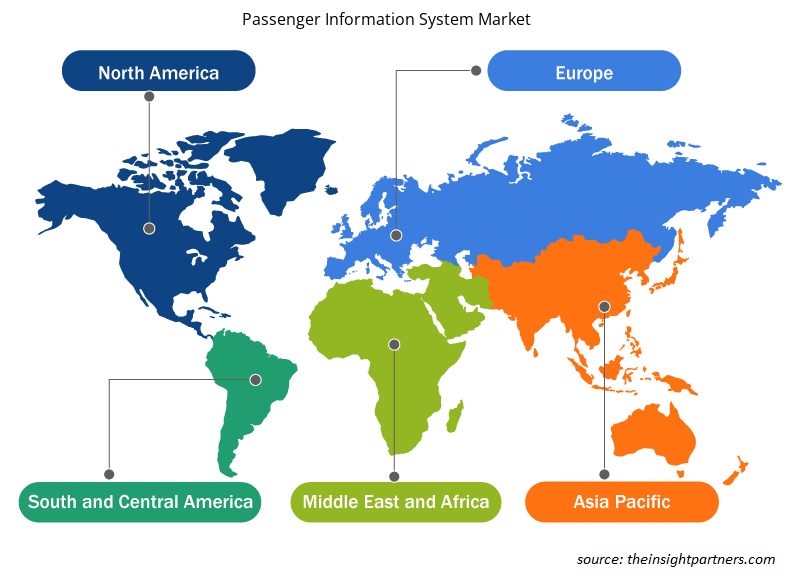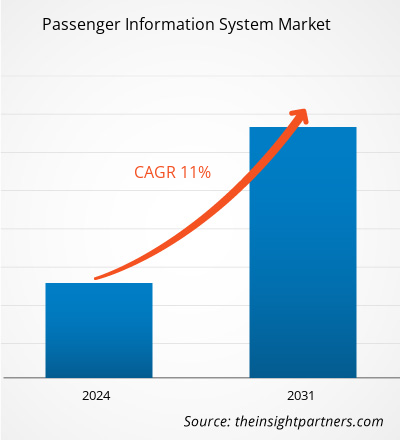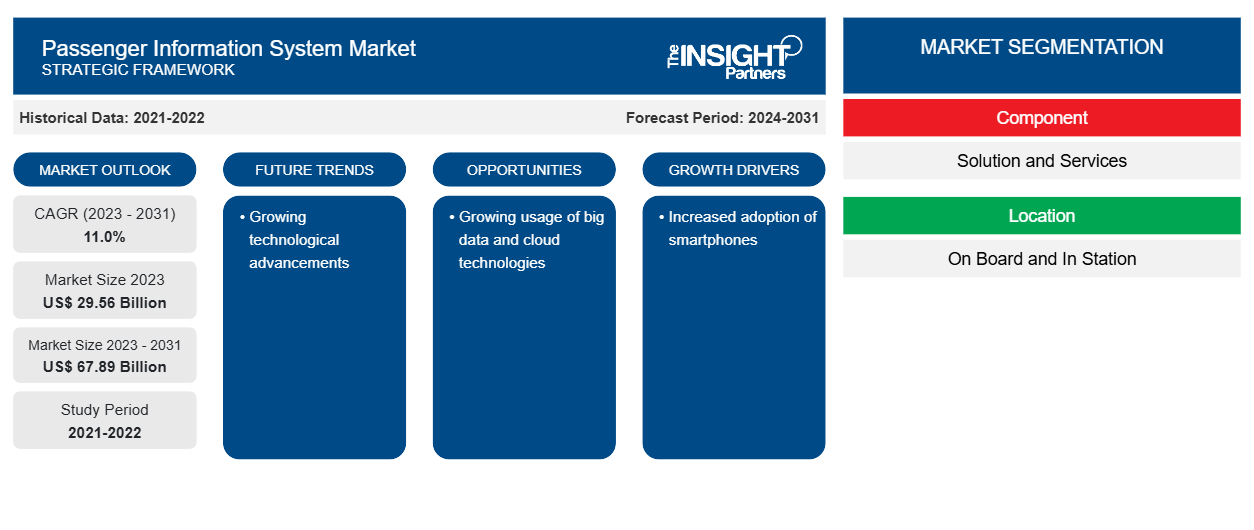预计乘客信息系统市场规模将从 2023 年的 295.6 亿美元增至 2031 年的 678.9 亿美元。预计 2023-2031 年市场复合年增长率为 11.0%。技术进步的不断进步可能仍是乘客信息系统市场的主要趋势。
乘客信息系统市场分析
乘客信息系统的需求增长是由于多种因素造成的,包括空中交通量的增加、智能交通系统的采用率提高、物联网解决方案在交通领域的渗透率提高以及乘客对实时交通信息的需求增加。此外,乘客信息系统市场预计将受益于对所有与旅行相关的信息(从行程规划到预计出发时间的变化)的需求增加。此外,预计交通机构对为客户提供更好的旅行体验的意识增强将刺激市场扩张。
乘客信息系统市场概况
乘客信息系统的目的是通过音频、视频和媒体设备为乘客提供有关交通服务状况和类型的最新信息。它由一系列硬件和 IT 组件组成。它还提供新闻和娱乐服务,以及预计到达和离开时间的详细信息,所有这些都有助于改善旅行体验。由于交通运输机构越来越需要为乘客提供准确可靠的实时交通信息,乘客信息系统市场正在扩大。此外,由于电信行业的发展使得数据传输能力更快,物联网在交通运输领域的应用激增,以及对智能交通系统的需求增加,市场也在不断扩大。
定制此报告以满足您的需求
您可以免费定制任何报告,包括本报告的部分内容、国家级分析、Excel 数据包,以及为初创企业和大学提供优惠和折扣
-
获取此报告的关键市场趋势。这个免费样品将包括数据分析,从市场趋势到估计和预测。
乘客信息系统市场驱动因素和机遇
智能手机普及率提高
由于智能手机使用率不断上升,基于移动应用程序的乘客信息系统正在迅速普及。此外,交通部门正专注于乘客信息系统移动应用程序,以吸引客户,并让他们通过智能手机渠道获取快速、准确、实时的信息。此外,公共交通多式联运应用程序的兴起也为市场扩张提供了机会。
大数据和云技术的使用日益增多
尤其是铁路部门,他们正在使用云计算来实现多种交通方式的自动化。利用云计算技术,乘客信息系统可以跟踪附近公交车的行踪。它确定到达时间,然后将其显示在公交车站的实时信息系统上。云技术和数据分析解决方案的利用有助于高效分配资源和经济地监控乘客人数。
乘客信息系统市场报告细分分析
有助于得出乘客信息系统市场分析的关键部分是组件、位置、交通方式和功能模型。
- 根据组件,乘客信息系统市场分为解决方案和服务。解决方案部分在 2023 年占据了更大的市场份额。
- 根据地点,市场分为车载和站内。车载部分在 2023 年占据了最大的市场份额。
- 就运输方式而言,市场分为公路、铁路、水路和航空。公路运输在 2023 年占据了市场主导地位。
- 根据功能模型,市场分为多媒体显示器、音频系统、计算系统、网络和通信设备、视频监控和内容管理系统。
乘客信息系统市场份额(按地区)分析
乘客信息系统市场报告的地理范围主要分为五个区域:北美、亚太地区、欧洲、中东和非洲以及南美/南美和中美洲。北美控制着全球乘客信息系统市场。此外,在预测期内,北美市场可能会高速增长。推动该领域市场扩张的主要因素是北美发达经济体和发展中经济体乘客信息系统的生产和消费量均有所增加。PIS 被视为最大的市场之一,其先进技术和强大的网络基础设施的使用率显著提高。由于公共交通使用增加和城市化速度加快等因素,该地区对乘客信息系统市场的扩张产生了重大影响。此外,预计乘客信息系统服务和解决方案的使用日益增多将促进其扩张。所有这些因素都有助于该地区乘客信息系统市场的增长。
乘客信息系统市场区域洞察
Insight Partners 的分析师已详尽解释了预测期内影响乘客信息系统市场的区域趋势和因素。本节还讨论了北美、欧洲、亚太地区、中东和非洲以及南美和中美洲的乘客信息系统市场细分和地理位置。

- 获取乘客信息系统市场的区域具体数据
乘客信息系统市场报告范围
| 报告属性 | 细节 |
|---|---|
| 2023 年的市场规模 | 295.6亿美元 |
| 2031 年市场规模 | 678.9 亿美元 |
| 全球复合年增长率(2023 - 2031) | 11.0% |
| 史料 | 2021-2022 |
| 预测期 | 2024-2031 |
| 涵盖的领域 |
按组件
|
| 覆盖地区和国家 |
北美
|
| 市场领导者和主要公司简介 |
|
市场参与者密度:了解其对商业动态的影响
乘客信息系统市场正在快速增长,这得益于最终用户需求的不断增长,这些需求源于消费者偏好的不断变化、技术进步以及对产品优势的认识不断提高等因素。随着需求的增加,企业正在扩大其产品范围,进行创新以满足消费者的需求,并利用新兴趋势,从而进一步推动市场增长。
市场参与者密度是指在特定市场或行业内运营的企业或公司的分布情况。它表明相对于给定市场空间的规模或总市场价值,有多少竞争对手(市场参与者)存在于该市场空间中。
在乘客信息系统市场运营的主要公司有:
- 泰来斯特集团
- 西门子股份公司
- 泰雷兹集团
- 立方公司
- 因陀罗系统公司
- 阿尔斯通
免责声明:上面列出的公司没有按照任何特定顺序排列。

- 了解乘客信息系统市场的主要参与者概况
乘客信息系统市场新闻和最新发展
乘客信息系统市场通过收集一手和二手研究后的定性和定量数据进行评估,其中包括重要的公司出版物、协会数据和数据库。以下是市场发展情况的列表:
- 2021 年 1 月,为了扩大其现有的交通技术组合,Cubic Corporation 推出了“UMO”全集成平台套件,面向出行、乘客、服务提供商和交通管理部门。UMO 是一套灵活的工具,可让用户安排乘坐公共交通和私人交通工具的行程、支付费用、获得出行奖励并接收最新信息以提高出行能力。
(来源:Cubic Corporation,公司网站)
- 2020 年 6 月,Wabtec 公司推出了“BlueFiIter”空气过滤装置,为火车和地铁上的乘客提供清洁、健康的环境。在轨道车中,BlueFilter 可消除 90% 以上的污染物。
(来源:Wabtec Corporation,公司网站)
乘客信息系统市场报告范围和交付成果
“乘客信息系统市场规模和预测(2021-2031 年)”报告对以下领域进行了详细的市场分析:
- 范围内所有主要细分市场的全球、区域和国家层面的市场规模和预测
- 市场动态,如驱动因素、限制因素和关键机遇
- 未来主要趋势
- 详细的 PEST/波特五力分析和 SWOT 分析
- 全球和区域市场分析涵盖关键市场趋势、主要参与者、法规和最新市场发展
- 行业格局和竞争分析,涵盖市场集中度、热点图分析、知名参与者和最新发展
- 详细的公司简介
- 历史分析(2 年)、基准年、预测(7 年)及复合年增长率
- PEST和SWOT分析
- 市场规模、价值/数量 - 全球、区域、国家
- 行业和竞争格局
- Excel 数据集
近期报告
客户评价
购买理由
- 明智的决策
- 了解市场动态
- 竞争分析
- 客户洞察
- 市场预测
- 风险规避
- 战略规划
- 投资论证
- 识别新兴市场
- 优化营销策略
- 提升运营效率
- 顺应监管趋势























 获取免费样品 - 乘客信息系统市场
获取免费样品 - 乘客信息系统市场